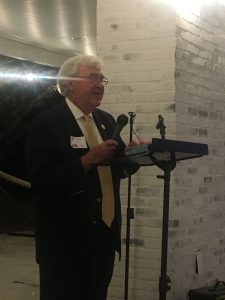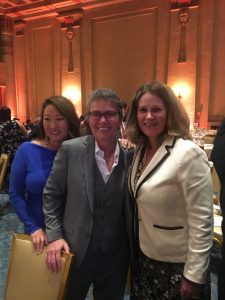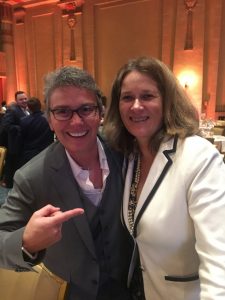Stonewall Bar Association Honors Judge Alex Manning
Last night I had the honor of introducing the recipient of the 2018 Stonewall Bar Association Conspicuous Service Award Winner, Judge Alex Manning. We had a wonderful evening with several hundred of my closest friends in the Fabulous Fox Egyptian Ballroom. Judge Manning gave an incredible, inspirational acceptance speech. I did not have all the time I wanted to introduce her. She has an awe-inspiring personal story and she is an example of service to her community. To further honor Judge Manning, I want to share my full introduction of her here. I am proud to know Judge Manning and proud to call her my friend. What a great night!
| ALEX MANNING INTRO STONEWALL BAR ASSOC. DINNER NOVEMBER 1, 2018 BY ROBIN FRAZER CLARK | 11/01/2018 |
Good Evening.
It is my distinct pleasure and proud honor to introduce to you tonight, the recipient of the Stonewall Bar Association Conspicuous Service Award, the Honorable Alexandra Manning.
Judge Alex Manning is a Judicial Officer in the Family Division of the Superior Court of Fulton County. She presides over some of the most contentious and sensitive calendars in Fulton County, including Child Support Contempt, TRO’s and Name Changes. She consistently and with the utmost respect for the rule of law and for the dignity of all those who appear before her, Judge Manning presides with both a firm hand and compassion. Judge Manning often handles name change petitions for transgender persons. Those who are seeking gender affirming name changes are often the most marginalized in our society and so come to court, understandably, vulnerable, with fear and intimidation of the formal court procedures. Many expect a judge who has little interest in helping them achieve their goal and even less understanding of why they desire to do so in the first place. You can imagine most of their reactions when they meet Judge Manning, who treats them with the dignity and respect they deserve but which they have rarely experienced by the government. Even though in 2018 we are still seeing some Superior Court judges refusing to grant a name change to a transgendered person out of some misguided personal beliefs, Judge Manning is not only a breath of fresh air in a sometimes-stagnant environment but is also the standard bearer for how judges should treat all citizens who come before them.
Judge Manning constantly demonstrated her support of the LGBTQ community before taking the bench. As a practicing lawyer she participated on a pro bono basis as co-counsel in a same gender marriage case in Dooly County, prior to the passage of Obergefell v. Hodges, in which she was able to protect the rights of a surviving spouse married in Washington, D.C., at a time when Georgia did not recognize same gender marriages. She also represented one of the first transgender individuals in the process of playing as a competitive NCAA athlete on the team that matched with gender identity. In her practice as a family lawyer she made handling second parent adoptions for LGBTQ parents a priority, even when not all Georgia court were even permitting second parent adoptions by a person of the same gender as the original adoptive parent.
Long before her legal career, Judge Manning established herself in law enforcement. She was a pioneer as one of the first waves of female certified firefighters in DeKalb County. She then went onto become a lead narcotic agent in the Georgia Bureau of Investigations and was appointed to the Governor’s Strike Force. She then became a Detective and K-9 handler and received both a Medal of Valor and Police Officer of the Year. While obtaining her undergraduate degree from Mercer University, Judge Manning worked as Senior Investigator with the Fulton County District Attorney’s Office in the Crimes Against Women and Children Unit and also at the Douglas County Public Defender’s Office. She then went to Vermont Law School and graduated in May 2006.
I first met Judge Manning when I was introduced to her at Lawyers Club by her loving partner, Lisa Liang. Lisa had wanted us to meet after learning I had successfully represented an Army Veteran in obtaining a Presidential Pardon for his military conviction of Conduct Unbecoming an Officer. His so-called unbecoming conduct was having a homosexual relationship with another man in the Army. My client was convicted and served two years in Ft. Leavenworth Prison and then was dishonorably discharged. After six years of representing him, we were overjoyed when we received word from the Pardon Counsel in the Department of Justice that President Obama was pardoning my client. As it turns out, Judge Manning endured a very similar episode in her life. Years before she distinguished herself as a GBI narcotics agent and before she was a Medal of Valor recipient and before she was named Police Officer of the Year, and before she became a respected judge on the Fulton County Family Court bench, she was discharged from the United States Army while a private. The reason for her discharge? Failure to adapt to military standards, which is Army speak for she was gay. Judge Manning disclosed this for the first time to attendees at a Vermont Law School conference on what was then the Federal policy on gays in the military, “Don’t Ask Don’t Tell (DADT). After revealing her long-kept secret, Alex began advocating for the repeal of DADT, including nationwide petitioning institutions of higher learning to ban military recruiting on campuses until DADT was repealed. Vermont Law School was one of the first to do so. Alex continued this important advocacy in Georgia until DADT was finally repealed in 2011.
Can you imagine an American citizen wanting to serve her Country and being told the only reason she won’t be allowed to do so is who she loves? Sounds crazy, doesn’t it? But, although DADT has been abolished, and although same gender citizens may now be married in any state in the United States, it would be wrong to say we are out of the woods of discrimination and we don’t ever have to worry about that again. We need look no further than to our current Administration’s constant threat to reinstitute a ban on gays and transgendered people in the military. Or the current Justice Department’s intervening in a private employment lawsuit arguing that the ban on sex discrimination in the Civil Rights Act of 1964 does not protect workers on the basis of their sexual orientation. Or the recent sentencing of a gay man to death by a South Dakota jury because sending him to prison for life would be sending him “where he wants to go and he shouldn’t be able to spend his life with men in prison.” The United States Supreme Court refused to grant the defendant’s certiorari petition on the basis of what was clearly anti-gay bias of the jury. Thus, you see why we must continue fighting the good fight.
In last year’s Pena-Rodriguez v. Colorado, 137 S. Ct. 855, 868, 197 L. Ed. 2d 107 (2017), Justice Kennedy wrote that “racial bias [is] a familiar and recurring evil that, if left unaddressed, would risk systemic injury to the administration of justice. This Court’s decisions demonstrate that racial bias implicates unique historical, constitutional, and institutional concerns. An effort to address the most grave and serious statements of racial bias is not an effort to perfect the jury but to ensure that our legal system remains capable of coming ever closer to the promise of equal treatment under the law that is so central to a functioning democracy.” Until we can easily substitute “sexual orientation bias” with “racial bias” in this sentence, we have not realized the Constitution’s promise of justice for all.
So, it is not hyperbole to say Judge Manning is a true American hero, for her example, for her sacrifice, for her honesty and openness, for her dedication to equality and to justice for all. She is exactly who we want on the bench, who can bring to bear her toughness forged by personal struggle but tempered with deep compassion. And it is with that courage in mind that tonight we fittingly honor Judge Alex Manning.
Please join me in congratulating Judge Manning.
Robin Frazer Clark is a trial lawyer who pursues justice for those who have personal injury claims as a result of being injured in motor vehicle wrecks, trucking wrecks, defective products, defective maintenance of roads, premises safety, medical malpractice and other incidents caused by the negligence of others. Ms. Clark is the 50th President of the State Bar of Georgia, a Past President of Georgia Trial Lawyers Association, a Past President of the Lawyers Club of Atlanta and has practiced law in Georgia for 30 years. She is a member of the International Society of Barristers and of the American Board of Trial Advocates. Mrs. Clark is listed as one of the Top 50 Women Trial Lawyers in Georgia and is a Georgia Super Lawyer.
Robin Frazer Clark ~ Dedicated to the Constitution’s Promise of Justice for All.
The Problem with Juror No. 7: When Can the Trial Judge Remove a Juror?


I have been following the talc trials against Johnson & Johnson regarding the claims that their powder product gives women ovarian cancer and lung cancer. I hope you have been, too. They are, obviously, very interesting. I can’t look at the Johnson & Johnson powder of bottle sitting on the vanity of the locker room where I work out without thinking about the cases and the many women who have died of these cancers allegedly from years and years of use of Johnson & Johnson powder. The most recent trial in California was just recently declared a mistrial by the trial judge, Judge Margaret Oldendorf. The case is Weirick v. Brenntag North America, BC656425, California Superior Court for Los Angeles County (Pasadena). It involved a claim that use of Johnson & Johnson powder had caused the plaintiff’s mesothelioma, a specific type of lung cancer. The Plaintiff, Weirick, 59, is a school counselor who said she’s been using J&J’s talc products, such as baby powder and the company’s former Shower-to-Shower line, for more than 40 years. She was diagnosed with mesothelioma in 2017 and said her only exposure to asbestos came from use of talc products. Previous juries had come out with verdicts of $25.75 million and $117 million for the plaintiffs, a defense verdict and two mistrials.
This latest trial in California was particularly interesting due to the alleged misconduct of one juror, now scandalously known as “Juror No. 7.” (By the way, if you are ever on a jury and in the course of the trial become known by your Number, it is never a good thing). Juror No. 7, apparently, refused to deliberate with the other 11 jurors, to the point that the foreman asked the judge to replace the juror with an alternate. The defense objected and asked for a mistrial. The plaintiff’s counsel agreed to the substitution. This is interesting because it was never disclosed what side Juror No. 7 was holding out for; Juror No. 7 could have been a juror favorable for the defense and yet defense counsel objected and moved for a mistrial. In fact, it was never disclosed which side the entire jury was leaning in favor of, only that at the time a mistrial was called by the trial judge, the vote was 8-4. At that time, neither side knew which side had the 8 jurors. Since then, it has come to light that the 8 jurors favored the Plaintiff. George Chen, a 30-year old computer analyst and one of the eight who favored a plaintiff verdict, said he was “a little frustrated” and “really wanted to push this through.” He said the four members who voted for the defense seemed to have ”the mindset of … business people” concerning what a responsible company should do.
Even if there were mere traces of asbestos, J&J should have provided warnings, Chen said, because “people have a right to know.” Moreover, he noted, J&J for decades has offered a baby powder made with corn starch, and could have retired the talc version to eliminate any risk.
What is the Role of a Trial Judge?

What is the role of a trial judge? This question may often be debated among lawyers and between lawyers and judges themselves and maybe even by law students in school, but rarely is it a hot topic discussed in the public by non-lawyers. Until now. You may be following the Paul Manafort trial, in which the trial judge has been both criticized and congratulated for his conduct in presiding over that trial. As I write this, the jury is out. By most news accounts, that trial judge, Hon. T.S. Ellis, has often made known his likes and dislikes to the jurors and the prosecution seems to be taking the brunt of the abuse. So much so, that the prosecution has filed at least two motions requesting the trial judge apologize and make it clear to the jury that his remarks are not to be taken as commentary on the strength or weakness of the prosecution’s case. Things seem to have finally boiled over when, one morning, the trial judge did just that, he essentially admonished himself to the jury for his comments and said “Put aside any criticism. I was probably wrong in that,” and Ellis said, concluding, “Any criticism of counsel should be put aside — it doesn’t have anything to do with this case.” “This robe doesn’t make me anything other than human.”
“This robe doesn’t make me anything other than human.” Think about that for a second. Who else wears a cape at work? A Super Hero? Every word that comes out of a trial judge’s mouth in front of a jury has some persuasion attached to it…some hidden meaning. Jurors often take their cues from the trial judge. If the trial judge doesn’t seem to like a certain attorney, well, guess what? The jury probably won’t like that attorney, either. Jurors may be thinking: “Who does the judge think should win? He’s the expert, he knows. Does he like the defense attorney better than the plaintiff’s attorney? Does she think the plaintiff is exaggerating? He was rude to the female lawyer…maybe he thinks she is incompetent? What will he think of us if we find for the plaintiff? And return a large verdict? Maybe he thinks that shouldn’t happen in his courtroom?” As one trial lawyer said about Judge Ellis. “He can be very dominating,” said Jim Brosnahan, a California trial lawyer who defended John Walker Lindh in the American Taliban casebefore Judge Ellis. “The interesting question is: Is it aimed fairly at both sides, or is it particularly at one side?” Also, keep in mind how extraordinary it is that Judge Ellis essentially apologized to the jury for his own comments, recognizing they may have sent the wrong signal to the jury. This is a very rare occurrence for a judge to do that.
First, let me say, that we are blessed with many wonderful trial judges in Georgia. I have tried nearly 75 jury trials in the last 30 years of practicing law, all in Georgia, and with the very blatant exception of one Superior Court judge (she knows who she is), I have always been treated with the utmost respect and courtesy by our trial judges. Even when we may disagree, we do so with civility, not taking personal shots at one another. That is not to say that some aren’t demanding, or controlling, or picky, or even temperamental. Many trial judges are all of those things, because they are human and sometimes the stress of a trial gets to them the way it gets to everyone involved or they simply see their role as being in command of their courtroom. It has been my experience that our Georgia trial judges treat all those who come before them with the civility expected out of someone who wears a robe, has her name on a courtroom and has been given the authority by the State to preside over a trial, which is often one of the most important moments in a citizen’s life.
Electric Scooters: The Newest Menace to Society


Transportation is constantly changing. The year 2002 brought us Segway Personal Transporters; 2009 gave us Uber (formerly “Ubercab”); 2010 brought bike-share companies to the U.S.; and 2017? Scooters. Yes, the same toys we used to ride around our neighborhoods as kids have now become electrified and are the newest, hippest mode of transportation in at least 21 states of the U.S. These electric scooter companies — namely Bird, Lime, and Spin — are taking cities by storm in recent months. People from the company drop off dozens of scooters at “nests” located around the city each morning for civilians to pick up. The person can pay through the app the $1 starting fee, ride it around — paying additionally by time or mileage — and then just drop the scooter off wherever he or she would like. At the end of the night, the company collects the scooters around the city to check for maintenance and repair needs and then deposits them around the city streets the next morning. At first blush, this idea seems great! Avoid traffic, get to a close distance quickly, and for cheap! Upon closer observation, however, just as the scooters seem to be taking over, more and more problems are quickly emerging with the newest toy-turned-transportation.
First, safety. There have been numerous accidents reported in the last few months as the scooters have become more readily available to the public. The websites and apps for these scooters suggest the riders should wear a helmet; however, there is no method of enforcement from the businesses, and when a person picks up a Bird to ride around town, a helmet does not come attached to the scooter for a rider to wear, and people walking around downtown are likely not already carrying a helmet with them when they get the urge to pick up a scooter. Bird only provides a helmet when a rider puts in a request for one. Personal injury attorneys across the country are reporting dozens of people seeking representation after getting injured on these scooters, and liability and insurance surrounding this latest mode of transportation is a relatively uncharted territory for these attorneys to try to manage. Liability can be hard to prove, and questions of insurance coverage for injuries can be tricky to answer; health insurance will say that car insurance should cover medical expenses, and car insurance points the finger back saying it won’t cover a crash on a two-wheeled vehicle. Oddly enough, according to one personal injury attorney, it’s possible that homeowners or renters insurance could cover a rider in these situations. Another attorney says that though Bird says that riders use the scooter at their own risk and limit its own liability to $100, the company’s waiver likely will not stop claims of gross negligence.
As if the safety concerns were not enough to label these scooters an official nuisance, the legal concerns may do it. According to the Official Code of Georgia, the operation of motor scooters is only mentioned once under the definition of “motor driven cycle” which also includes motorcycles, bicycles with motors attached, and mopeds. Clearly, these newly innovated technological devices (electric scooters) have yet to be addressed by many state legal codes. Because of the lack of specificity in the Code regarding the definition of electric scooters, cities around the country are interpreting law one way, and the scooter companies are interpreting it the other way. The companies do not want riders using the scooters on sidewalks, and the Cities don’t want the riders using them on streets. Additionally, confusion over whether the scooters need license and registration has been at the center of much debate over the legality of the scooters. One of the main legal concerns and problems the cities and public are having with the electric scooters is the sidewalk litter they cause. Because a rider is able to pick up, ride, and drop off the scooter wherever he or she pleases, the “dockless” nature of these scooters is causing sidewalks to fill up with scooters disposed of by inconsiderate riders, blocking pedestrians’ and wheelchairs’ paths. Though many of the legal concerns are up for debate right now, the issue surrounding the blocking of the sidewalk is not one to be misinterpreted; O.C.G.A. § 16-11-43 says it is illegal to recklessly obstruct any “sidewalk, or other public passage in such a way as to render it impassable without unreasonable inconvenience or hazard” and failure to remove the obstruction — namely, the electric scooter left lying in the middle of the sidewalk — after an official request to do so is a misdemeanor offense.
Pedestrian Fatalities on the Rise in Georgia: Who’s at fault and who’s at risk?
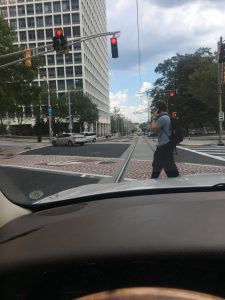
Taking a stroll down the streets of Atlanta can be a healthy pastime or a means of getting in your social interactions for the week, but the cheapest form of transportation is quickly becoming one of the more dangerous. One unfortunate story in Smyrna, GA last week tells of a pedestrian fatality at the hands of a distracted driver; the driver made a phone call, drove off of the roadway, and struck the pedestrian. Another upsetting story in the AJC last week reported of a woman killed in Atlanta as she attempted to cross I-75 and was struck by multiple cars. Recent reports suggest that she attempted to run across the highway due to a dispute over drugs that resulted in someone chasing her. Unfortunately, this story is just one of many that could be written in Georgia this year, as pedestrian fatalities are on the rise on the national level. From 2007 to 2016, the number of pedestrian fatalities increased by 27%, and whether the victim is a harmless pedestrian walking to work or drugs are at play, researchers are not quite certain what is the main cause for the increasing numbers of pedestrian fatalities in the recent years.
Reports over the last few years have found a few potential factors to the increasing fatalities. Obviously, cell phone usage is an issue. Whether a distracted driver is using a phone while operating a vehicle or a distracted pedestrian has his or her face buried in the phone while walking through a crosswalk, cell phones are making us more distracted, less aware of our surroundings, and slower to react when we encounter danger. Cell phone use increased by 236% in the years 2010 to 2016, providing greater opportunity for cell phone related pedestrian accidents.
Many studies and reports suggest the increase in cell phone usage could be a leading cause of pedestrian involved accidents, but a new study provides an interesting possible factor in the rising number of pedestrian fatalities: marijuana. The report does not intend to imply direct correlation of any sort but merely suggests that the possible impairment of judgment and reaction time — for both drivers and pedestrians — due to recreational use of marijuana could lead to higher pedestrian incidents on the roadway. The study found that in DC and the 7 states that legalized recreational use of marijuana between 2012 and 2016, there was a collective 16.4% INCREASE in pedestrian fatalities between the first 6 months of 2016 and the first 6 months of 2017. Conversely, in the remaining states, there was a collective 5.8% DECREASE in pedestrian fatalities between those two time spans.
Georgia’s Hands-free Distracted Driving Bill: What you need to know
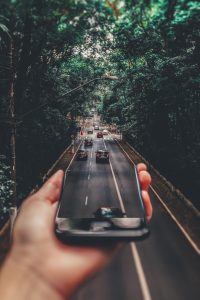
In a series of blogs I wrote last summer on distracted driving, I laid out some of the problems with the advancing technology we have readily available to us at our fingertips. The use of social media apps like Snapchat and Instagram while driving has led to many fatal or injurious car wrecks, and texting while driving, which is known as a “combination distraction” – one that averts our attention manually, visually, and cognitively – has caused thousands of deaths and injuries in accidents in the last few years. Last summer, one of my distracted driving blogs was about a bill that the Governor of Washington was signing into law banning hand-held usage of cellular devices. I wrote that Georgia had yet to sign such a bill into its own laws, but one year later, this subject matter needs an update.
This legislative session, the Georgia Legislature worked to pass House Bill 673, which Georgia Governor Nathan Deal signed into law a few months ago and will become effective July 1, 2018. The bill is known as the “Hands-Free” or “Distracted Driving” law, which by name alone may sound self-explanatory but with further inspection can be a little confusing. Allow me to lay out the need-to-knows of Georgia’s newest cell-phone driving law.
This bill, which has now become an Act, amends Title 40 “Motor Vehicles and Traffic” of the Official Code of Georgia Annotated. The main change in the Code will be located in O.C.G.A. §40-6-241, which explains a driver’s responsibility to exercise due care, specifically regarding usage of a wireless telecommunications device. The first parts of the bill change the penalties within the license point system. First violation of Code Section 40-6-241 will result in 1 point added to the license; second violation results in 2 points added; and third results in 3 points. There are other – and potentially worse – penalties a driver could face if convicted of violating the Code section.
My Car Was Totaled in a Wreck: Can I Get Rid of It?
One of the first questions many of my clients have after they have been in a car wreck is whether they can accept the insurance company’s pay-off for their totaled car. Most people need the pay-off money to be able to buy substitute transportation as quickly as possible. Some people accept the insurance company’s pay-off well before they even think about hiring a lawyer, and well before they have even spoken to a lawyer about representing them in a car wreck case. This is certainly understandable and normal human conduct when your car has been totaled in a wreck that isn’t your fault. But can there be a problem with accepting the insurance company’s pay-off for your car and, in return, releasing ownership of it to that insurance company for salvage value?
Typically, in a car wreck that has resulted in some personal injuries due to the negligence of the at-fault driver for say, running a stop sign, or rear-ending the car in front, the answer for at least 30 years has been no. In the past, no insurance carrier ever really cared about preserving the car in a plain ordinary negligence car wreck case where there is no evidence of any mechanical failure of the car or any evidence that the car itself was, somehow, defective. In the last 5 years or so, however, that has changed. Now, in an increasingly scorched-earth tactic by defense lawyers, they often file a motion to dismiss even run-of-the-mill car wreck cases for the plaintiff’s failure to preserve or keep the car that was involved in the wreck, even if that car was totaled by the insurance carrier. This motion is referred to as a “spoliation motion” and they are becoming more and more popular as a “gotcha” tactic by defense attorneys who really have no defense for their insured’s actions in actually causing the wreck in the first place. They have to admit their insured was negligent and caused the wreck, but maybe they can get out of the whole thing by arguing that without the car to be examined by an expert, hypothetically, we can never know whether something was wrong with the brakes or the windshield wipers (yes, I have really had that argued by defense counsel in a case) or the seat belts or any of a number of made-up potential problems, even if there exists no evidence that anything about the car caused or contributed to the wreck. At a minimum it is frustrating…at the worst, it can cost a plaintiff her entire case.
Am I Safe Walking in a Crosswalk?



Every day as I travel down Edgewood Avenue in Downtown Atlanta in the middle of Georgia State University, some pedestrian, without fail, decides to take a risk and walk out in front of either my car or another car as I watch. The only time this doesn’t happen is when Georgia State is on Spring Break. It is a stressful trip, knowing that in addition to the numerous cars all around me that I have to be aware of, I have to be ready to slam my breaks in a nanosecond to avoid hitting a pedestrian walking out in front of my car when I have the right-of-way. I am aware of the plentiful crosswalks available for pedestrian use, but they are mostly ignored. I am talking about students who ignore the crossing signals and walk across a street either not in a crosswalk at all, or in a crosswalk but cross when the signal is telling them to stop. This typical daily occurrence with pedestrians has me thinking about just exactly what are the laws in Georgia pertaining to pedestrians? Is it just me or are the pedestrian signals getting more complicated? What do they actually mean? When does a pedestrian have the right-of-way to cross the street? Can a driver of a vehicle just mow down a pedestrian if the pedestrian is not in the crosswalk? How about if the pedestrian is in the crosswalk but the flashing hand has started with a stopwatch ticking down, telling the pedstrian how many seconds he or she has to cross the street before the signal turns? Is a pedestrian required to know how fast they can walk and how many seconds they typically take to cross a street? Does it depend on how many lanes the street is? And whether there is a headwind or tailwind? My drive today has me thinking about all of this. Hmmm….
First, we can easily find the Georgia Rules of the Road as they pertain to pedestrians on the Georgia Highway Safety website. The Official Code of Georgia provides: § 40-6-91. Right of Way in Crosswalks:
(a) The driver of a vehicle shall stop and remain stopped to allow a pedestrian to cross the roadway within a crosswalk when the pedestrian is upon the half of the roadway upon which the vehicle is traveling, or when the pedestrian is approaching and is within one lane of the half of the roadway on which the vehicle is traveling or onto which it is turning. For the purposes of this subsection, “half of the roadway” means all traffic lanes carrying traffic in one direction of travel.
Why It’s a Bad Idea to Allow Jurors to Ask Questions at Trial

It seems to be in vogue with some trial judges currently to allow jurors to ask questions of witnesses after both sides of the litigation are finished asking their questions. This is currently a hot topic due to the Tex McIver trial, currently being tried in the Fulton County Superior Court in front of Judge Robert McBurney. Judge McBurney, rather famously, permits jurors to ask questions of witnesses after questioning by the prosecution and the defense counsel. Presumably, Judge McBurney allows this practice in civil cases as well as criminal cases, although Superior Court doesn’t see as many civil cases as criminal. All felonies in Georgia must be tried in Superior Court. The practice of Judge McBurney allowing witnesses to ask their own questions was discussed extensively before the trial in a podcast produced by the AJC called Breakdown. It is hosted by veteran legal affairs journalist Bill Rankin and I highly recommend it. In that podcast, defense counsel Bruce Harvey gives his opinion on why it is not only a bad practice to allow jurors to ask questions, but, also, why it is probably unconstitutional. For example, we all know that the 5th Amendment of the Constitution gives a criminal defendant the right to remain silent, even throughout the trial, so that the government must prove guilt beyond a reasonable doubt without any assistance from the defendant. Harvey, rightfully, preposes the hypothetical of a juror asking “Why didn’t the defendant take the stand to tell us what happened?” Of course, the judge is not going to permit that question to be answered, but the jurors (or at least the one juror who asked that question) will know the judge didn’t approve it and wouldn’t permit it to be answered, and the bias that answers “why” is naturally because the defendant must be guilty. So simply by denying that juror’s question, the 5th amendment constitutional right is implicated and violated because it was allowed even to be raised in court.
There has lately been alot of discussion in social media about this among lawyers, too. You can find some of this discussion on Twitter at #texmciver and in the comments on Facebook where WSBTV is livestreaming the trial. If I were to take a poll, I think the vast majority of trial lawyers is against the practice for the reasons stated above. Also, other websites are livestreaming the same WSBTV feed, like wildabouttrial and lawandcrime. Both of these websites have a comments section where viewers can post their comments about the trial. It is pretty fascinating, especially for court enthusiasts like me. On Facebook, there have been some thought-provoking comments about allowing jurors to ask questions of witnesses. Below are just some of the comments I have seen:
“I think there are two questions that judges should ask themselves before considering this. 1). Why would I allow jurors to ask questions? Whatever the answer is (to help the jurors clarify any issues that the holder of the burden of proof has not clarified, etc). 2). If I am am being a neutral, unbiased referee, should that matter to me?”
 Atlanta Injury Lawyer Blog
Atlanta Injury Lawyer Blog




